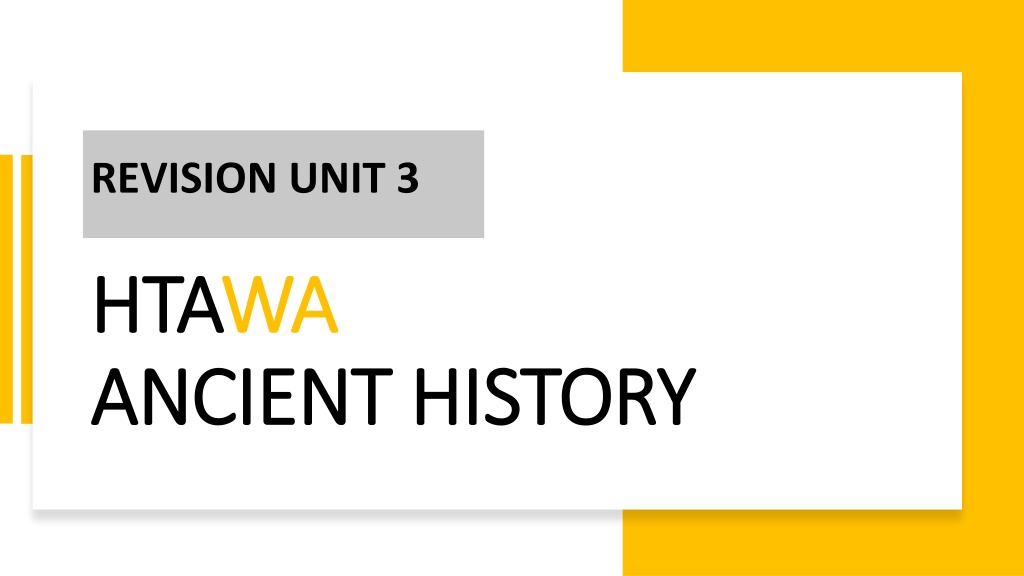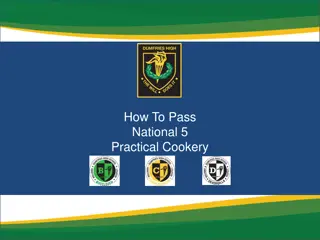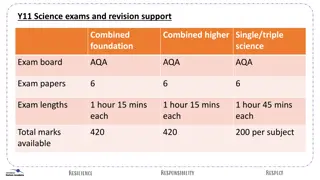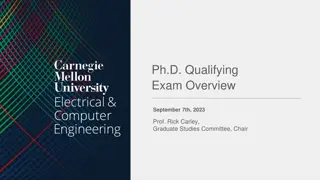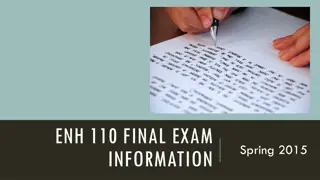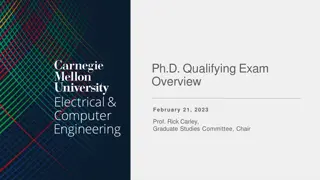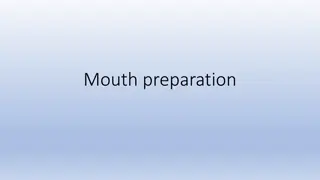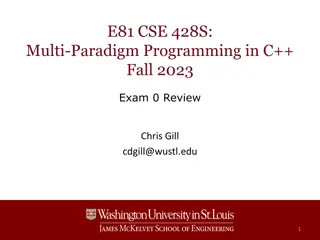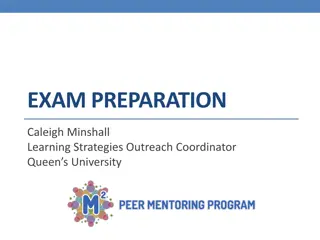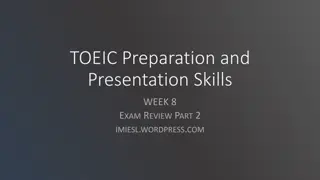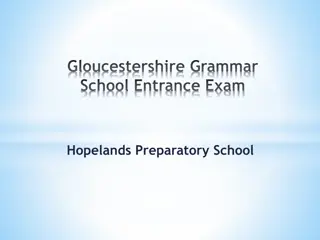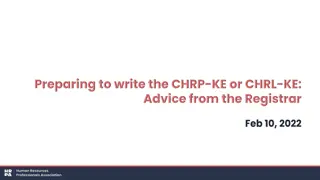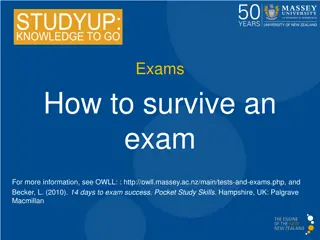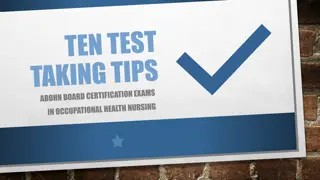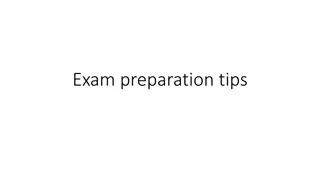Exam Preparation Tips for Ancient History: Strategies for Success
Enhance your exam preparation with these valuable tips for the Ancient History exam. From expanding your vocabulary to structuring your answers, these suggestions will help you effectively tackle the short answer section and excel in providing detailed responses, as demonstrated in the example answers provided.
Download Presentation

Please find below an Image/Link to download the presentation.
The content on the website is provided AS IS for your information and personal use only. It may not be sold, licensed, or shared on other websites without obtaining consent from the author. Download presentation by click this link. If you encounter any issues during the download, it is possible that the publisher has removed the file from their server.
E N D
Presentation Transcript
REVISION UNIT 3 HTA HTAWA ANCIENT HISTORY ANCIENT HISTORY WA
GENERAL IDEAS/SUGGESTIONS 1. Expand your vocabulary (buy/use an online Thesaurus) 2. Don t do the exam in order, you can start with ANY section or either of the two essays. 3. During reading time, think carefully about the questions and work out which ones will need to be planned thoroughly, and may therefore take longer. Allocate enough time to each question. WRITE THE TIME YOU WILL NEED TO ALLOCATE TO EACH QUESTION DOWN ON YOUR PAPER
SHORT ANSWER SECTION Important doing words: Describe (briefly) Outline (and ) Identify (and ) Discuss briefly Compare Assess Examine NEVER WRITE NOTHING STRUCTURE: 6 marks: CHOICE of 5 questions, Answer 4 in 40 minutes (10 MINUTES and 6 MARKS EACH) TIPS FOR SUCCESS: 1.KNOW YOUR SYLLABUS Questions are drawn directly from key syllabus points places, events, people, things FIND 2 key points on the syllabus (do this with someone else and share the workload). Brainstorm what you know about it. 2 minutes. For the exam you must be able to do this for ALL of these points. Try turning it into a quiz (or a Quizlet?) split the syllabus into sections with a friend or study group, prepare questions and answers for your section, quiz, and swap answers. 2. Use an introductory sentence for your answers have a concluding sentence. Especially important because these are 6 mark questions, and structure will improve your overall response
EXAMPLE ANSWERS EGYPT: Question - Identify and explain two ways in which the Cult of Amun increased in power during Dynasty 18. Two interlinked ways in which the Cult of Amun increased in power in the 18th Dynasty was due to building programs and the military successes of the New Kingdom pharaohs. As Barry Kemp asserts in Ancient Egypt: Anatomy of a Civilisation, in the 18th Dynasty people in general lived in the shadows of giant stone constructions . Cult temples, dedicated primarily to Amun, were mediums through which pharaohs could display their pious devotion to Amun thus underwriting the power of the god. By dedicating temples to the god Amun, such as the monumental Temple of Amun - Re at Karnak, the pharaohs were offering this god the power and wealth of the Egyptian Empire that had been gained through military successes. As a result the Cult was legitimised and strengthened and it increased in power as each successive pharaoh built monuments to the god. The Cult of Amun increased its power through the actual wealth in material offerings to the priesthood s coffers that came as a result of Egyptian military successes. At the very start of the 18thDynasty the Pharaoh Ahmose s stele at Karnak lists offerings of large wreaths of gold, lapis lazuli and gold jewellery as well as jars of silver and of gold; fabulous wealth donated to the god Amun. This was wealth which added to the power and status of the Cult of Amun.
EGYPT: Identify and describe three benefits of the Pharaonic building programs in the 18th dynasty. 18th dynasty building programs would have had religious, political and economic benefits for different areas of the Egyptian state and its people. Religious benefit would have come from the building of more and greater temples which glorified all gods but in particular Amun/Amun - Re, the god of Thebes and of the Theban kings. Temples with large, elaborate building programs could attract could attract enormous power and wealth through endowments of land and gifts of precious items. This enhanced the status of the gods and the status of the pharaoh. Politically the building of massive structures such as mortuary temples, cult temples, and palaces along with all their chapels, obelisks, stele, and everything that supported an increasingly huge number of priests, storage for grain, activities for festivals, and the everyday working of the buildings, underscored the power and wealth of the ruler and the state on every conceivable level. Building programs advertised this political power to Egypt s international allies and enemies. Economic benefits can be seen in the increased need for skilled and unskilled workers, artists and craftsmen as well as the bureaucracy and professionals such as architects and engineers who worked on these projects. Specialists in transporting stone were also needed. Therefore everyone from potters, brickmakers, stone masons, to jewellers and sculptors, were in demand as the building and furnishing of the pharaohs palaces and temples raised the standard of living for all and benefitted both the local and wider Egyptian community.
GREECE: Identify and brieflydescribe the original structure of the Delian League including the terms agreed upon by Athens and her allies at the time of the foundation of the Delian League. Thucydides provides a summary of the structure/terms agreed upon for the League by Athens and its allies in Book 1 though does not mention whether the league was intended to be permanent or not. The terms were: The Athenians assessed which cities were to supply money for the war against Persia and which cities were to supply ships. Aristides was appointed to oversee the process of the allied contributions. Failure to supply ships or provide Phoros was used later as a pretext for the suppression of allies The office of the Hellenotamioi ( Treasurers of the Greeks ) was established and held by Athenians The first assessment of the tribute was 460 talents The treasury would be held at Delos The assembly (synod) of the league were to meet in the temple at Delos Aristotle provides more information about the oath administered by Aristides which was taken and ratified between Athens and her allies by sinking lumps of metal in the sea. The implication of this action is that the oath was permanent, therefore that secession was forbidden. The allies pledged not to refuse to serve in League campaigns. The oath pledged the allies to act defensively and offensively ( the same friends and enemies ), a common clause in a number of defensive and offensive treaties at the time. However, Athens was hegemon and the allies swore individually to have the same friends and enemies as Athens which emphasizes the point that Athens was dominant from the start. The offensive nature of the League is indicated by its action against Persia and by Athens view that failure to perform military duties was considered an offense (Thucydides 1.99 and 6.76). Defence against Persia was guaranteed to members, but the extent to which the League provided protection for member states from each other is unclear, though war between members of the league does appear to have been prohibited (Thucydides 6.76). Certainly Athens used members aggression against each other as a pretext to reduce members.
GREECE: Briefly explainhow Athens actions at Naxos and Thasos illustrate Athens increasing imperialism. Naxoshad been an original member of the Delian League. Thucydides clearly states that Athens made war on the Naxians, who had revolted and subdued them by siege: Naxos was the first allied city to be enslaved . The Naxians were treated harshly by Athens: they suffered loss of autonomy; an Athenian garrison was established; their fleet was confiscated; and it is possible a pro-Athenian democratic constitution was also established. Thucydides does not tell us why Naxos revolted, but makes it clear that Naxos was forced back into the League after the failed revolt. Athens actions perhaps indicates the growing nature of Athenian imperialism as a result of Athens not having to deal with much Persian opposition at this time, which meant that Athens was free to interfere with her member states. It has also been suggested that Naxos was the focus of Athenian attention because control over it was of strategic importance it had been a Persian target during the Ionian Revolt and thus could not be allowed to secede. The Athenian actions at Thasos were more blatantly self-serving. Thasos revolted. Thucydides tells us that this was related to a dispute over trading posts on the coast of Thrace and over the mine from which Thasos enjoyed the profits . Both the trading posts and the mine clearly belonged to Thasos, therefore any dispute over it with Athens was likely linked to Athens attempt to assume commercial control over assets to which she had no real claim. What occurred at Thasos is therefore clear evidence of the growth of Athens imperialism. Problems in the area were perhaps made worse by Athens attempt to found the colony of Nine Ways close by, possibly as part of a plan to gain wider control over that part of the Thraceward region. Thasos was subdued by a lengthy and somewhat untidy siege, during which time the Thasians successfully murdered the majority of the Athenian settlers in Nine Ways. The siege also threatened to draw Sparta into war against Athens, when Sparta agreed to assist the Thasians in repelling Athens, although they were unable to deliver this aid in the end due to more pressing concerns over the ongoing helot revolt and an earthquake. Certainly Diodorus indicates that Athens power at this time (the late 460s) was increasing considerably, and they no longer treated their allies fairly as they had done before but ruled them violently and overbearingly , going on to add that the majority of the allies felt oppressed and were therefore turning away from the central council of the League and making their own arrangements . Diodorus implies that many were discussing revolt by 464/3, just about at the time of the end of the siege of Thasos. However many of the allies had become phoros paying members of the League by this time and were easily suppressed by Athens.
ROME: Explain three reasons why Spartacus rebellion was a significant threat to Rome. The brutality of the Roman reaction to the slave revolt is not surprising - slavery was an essential part of the economy, the life and the culture of Rome - and any weakening of it as an institution was therefore treated very seriously. Initially, Rome s response to the revolt in 73 was low-key, but after a string of defeats of the Roman forces under the command of various praetors and legates the numbers of slaves (and some free men) who joined Spartacus increased dramatically - perhaps as many as 70,000 (possibly up to 100,000). It was soon obvious to Rome that the revolt was far more serious than had been initially anticipated - rebellious slaves had never been tolerated and were shown no mercy but this revolt was different, not only because of sheer number of slaves that were involved but also because of the military defeats that had been suffered by the Roman forces. A critical point was reached at the end of 73 or beginning of 72 (winter) when the slave rebels split into two forces - one led by Spartacus, who argued that the best action would be to march north and leave Italy before the Romans could organise more forces, and the second group led by Crixus (Spartacus co-leader) who was much more interested in plundering southern Italy. What worked in Rome s favour was this disunity which had begun to emerge amongst the rebellious slaves. Despite the split in the slave forces and the resounding defeat of Crixus and his followers, Spartacus was able to defeat both Roman commanders sent against him this was a formidable force and it had managed to get very close to Rome. Rome could not and would not allow a serious rebellion to happen - slavery was essential in Roman society and to the Roman economy and the total submission of the slaves was necessary for the smooth functioning of the slavery industry . Rome could not turn its back on this slave rebellion as it was necessary to send a clear message to its slave population that obedience was expected. The 6000 crucifixions of the rebels along the Via Appia which followed the defeat underscored this expectation.
ROME: Briefly describe the origins of the Social War. The disagreement between Rome and the allies was long term. The allies had asked for citizenship based on legitimate claims/concerns: citizenship would grant them protection from the corruption of Roman officials Taxation on the allies was harsh They were not included in the distribution of tribute after military campaigns They had contributed men and resources to the Roman army for generations, Roman expansion could not have occurred without them, but Rome had been curiously resistant to rewarding their loyalty The Lex Licinia Mucia of 95 had inflamed the situation considerably The allied situation had generated support in Rome for some time Gaius Gracchus had campaigned for improvements in 122-121 BC. In 91 BC Drusus worked toward gaining enfranchisement for the allies but was blocked by an uncompromising senate who refused to extend Roman privileges to the Italians, and by Italians themselves who feared they might lose land under his agrarian reforms. His death was one of the triggers of the outbreak of war Additionally, the senate refused to listen to a deputation of allies sent to protest Rome s past treatment of them, leading to a bloody uprising in Asculum against its Praetor. Also, the highlanders of Picenum and Samnium were determined to fight for their freedom Denied equality, the allies fought for independence - this was a war of secession
HOW IS THE SHORT ANSWER SECTION MARKED ? Markers are looking for detail and accuracy in SHORT ANSWER responses ACTIVITY 1: Get onto the SCSA website (or click on the link below ) and look at the marking keys for each of the short answers from the 2019 exam: https://senior- secondary.scsa.wa.edu.au/__data/assets/pdf_file/0017/593000/2019_HIA_Ratified_Marking _Key_web_version.PDF WHAT DESCRIBING WORDS can you see for the 9-10 mark section of the marking keys? Write them down. What describing words can you see for the 5-6 mark section of the marking keys? Write them down. Identify the different words used for a top A (9-10 marks) and a C (5-6 marks) response
WHAT DOES A GOOD SHORT ANSWER LOOK LIKE? ACTIVITY 2: Go back and re-read all of the short answer examples above, FOR ALL 3 CONTEXTS (Egypt, Greece, Rome). Look for the ways in which each answer does things from the 9-10 mark section of the marking key: Identify (you might highlight or underline) where each: answered the question clearly (explained or described or outlined or identified, or discussed, or WHATEVER the question was asking for) used their contextual knowledge of the period they studied used an ancient and/or modern source to help support their answer
SOURCE ANALYSIS You may not have done a lot of Source Analysis assessment this semester. This might be because your teacher has decided to focus on the types of assessment (Short Answer and Essay) that are examined in the Unit 3 part of the exam. HOWEVER, source analysis is difficult and the more you practice, the better your skills will be and the more confident you will become.
SOURCE ANALYSIS SKILLS Key Points: 1. Know your syllabus Be able to identify areas in your syllabus which are contestable (can be debated) because, reliability, perspective and contestability are KEY historical skills which the syllabus (and the exam therefore) requires you to demonstrate. IMPORTANT WORDS TO DEFINE: Context Perspective Purpose Reliability Contestability Accuracy Usefulness Motive Opinion 2. The sources represent big ideas from the syllabus 3. The sources analysis is designed to allow you to demonstrate your understanding of historicity this is when historians look carefully at the reliability/accuracy of the information we have about an event, idea, person. To do this we need to consider these things
4. In reading time at the start of the exam: a)Identify the time period and/or section of the syllabus from which the source analysis is drawn (what is the context?). b) What is the message (key idea) of the source (if there are two parts to the source they will have a message about the SAME section of the syllabus the idea of having 2 parts to the source is to help make the message CLEARER). d) What is contestable about the source ? (what other information is there which agrees or disagrees with the information in the source ancient and/or modern this will help you consider the reliability, perspective, accuracy and usefulness of the source)
SOURCE ANALSYSIS QUESTIONS The question will ask you to: ANALYSE, EVALUATE, ASSESS or COMMENT UPON the OPINION, the PERSPECTIVE, the RELIABILITY, or the USEFULLNESS of the source in some way. MORE IMPORTANT WORDS TO DEFINE: Analyse Assess Evaluate This forms the KEY part of the question, and is what you must address in your answer. NOTE: the question may also include some scaffolding to help you answer the KEY part of the question. For example the scaffolding might: ask you to give some relevant CONTEXTUAL background information. This is because the background narrative (or the story ) of the event or idea or person that the source is depicting is IMPORTANT in understanding the source. ALSO ask you to pay attention to particular ideas/events or people that are important for you to answer the question well. NOTE: Comment upon means explain and/or describe To answer the question, use the SCAFFOLDING in the question to HELP YOU answer the KEY part of the QUESTION well. BUT BEWARE, if you ONLY address the scaffolding you have NOT answered the question.
EXAMPLE SOURCE ANALSYSIS QUESTIONS This is how the questions might look on the exam paper: EGYPT: With reference to source 2a) and 2b) and to the temple of Karnak itself, assess the extent to which the cult temple of Karnak is an important source for the period of study. In your answer you should consider the historical and religious information in the cult temple of Karnak, and you should consider the importance of the information in the cult temple of Karnak for an understanding of the period of study. GREECE: With reference to the source and to your knowledge of the period, assess the accuracy of Thucydides representation of Cleon. In your answer you should consider the historical context of events described, Thucydides perspective of Cleon, and other evidence and/or examples of Cleon's actions in the Archidamian War. ROME: With reference to the source and using your knowledge of your period of study, assess the evidence from the ancient and modern sources that Caesar desired kingship. In your answer you should outline the historical context and describe and explain Caesar s constitutional power.
IDENTIFYING WHAT THE QUESTION WANTS YOU TO DO HERE ARE THE SAME QUESTIONS AGAIN This time each has been broken down into 2 parts (EGYPT) Part 1: THE KEY PART OF THE QUESTION With reference to source 2a) and 2b) and to the temple of Karnak itself, assess the extent to which the cult temple of Karnak is an important source for the period of study. And Part 2: THE SCAFFOLDING. In your answer you should consider the historical and religious information in the cult temple of Karnak, and you should consider the importance of the information in the cult temple of Karnak for an understanding of the period of study NOTE: This scaffolding is something which the examiners want you to consider so that you answer the key part of the question as well as you possibly can.
IDENTIFYING WHAT THE QUESTION WANTS YOU TO DO HERE ARE THE SAME QUESTIONS AGAIN This time each has been broken down into 2 parts (GREECE) Part 1: THE KEY PART OF THE QUESTION With reference to the source and to your knowledge of the period, assess the accuracy of Thucydides representation of Cleon. And Part 2: THE SCAFFOLDING In your answer you should consider the historical context of events described, Thucydides perspective of Cleon and other evidence and/or examples of Cleon's actions in the Archidamian War. NOTE: This scaffolding is something which the examiners want you to consider so that you answer the key part of the question as well as you possibly can.
IDENTIFYING WHAT THE QUESTION WANTS YOU TO DO HERE ARE THE SAME QUESTIONS AGAIN This time each has been broken down into 2 parts (ROME) Part 1: THE KEY PART OF THE QUESTION With reference to the source and using your knowledge of your period of study, assess the evidence from the ancient and modern sources that Caesar desired kingship. And Part 2: THE SCAFFOLDING In your answer you should outline the historical context and describe and explain Caesar s constitutional power. NOTE: This scaffolding is something which the examiners want you to consider so that you answer the key part of the question as well as you possibly can.
Translation: point of view of the source and/or its author To identify the perspective/opinion, think about: Who theRole/position and status of the author? Does this make their information positive or negative in any way? (this might have links to bias below) About Perspective/Opinion When the way or extent to which the source/author was influenced by what events or ideas, or other people from certain time periods? Can certain beliefs or ideas be linked to certain time periods? (This might have links to bias below) Why what was/is the MOTIVE of the author? What was/is the PURPOSE of the author? Does this affect their point of view? How? (This might have links to bias below) Bias is the source, or the author, in favour of something? or critical of something? (Is this source therefore contestable?) Both modern and ancient sources, written and material, can have bias. NOTE: About Modern Sources such as text books MODERN Historians do have BIAS. Educational (didactic) sources do opine (have an opinion). Just because they had a lot of information to help them put their ideas together in an authoritative manner, this DOES NOT mean they have a neutral perspective or that they have NO opinion, OR that they present ALL the information in an unbiased way. Neither does it mean that they present ALL the available information. They are not infallible. TASK: Look through your textbook for OPINIONS. Where can you see that your textbooks are persuading you? How? What language are they using? What evidence do they use? Can you see when/if they omit information?
About ACCURACY If you see this word in the question, you are being asked to think about the strengths and weaknesses of the information in the source. How precise or truthful is this information? To answer a question like this, you need to use what you know about the historical context and any other relevant information from the Ancient and or Modern sources to help you argue how accurate the source is. About USEFULNESS If you see this word in the question, you are ALSO being asked to think about the strengths and weaknesses of the information in the source. In this case you must consider how helpful the information in the source is in helping you understand whatever the source is about. You will need to identify what it explains or describes well (and possibly HOW it does this), and what it omits (leaves out). Does it have a strong perspective/opinion in it that makes it difficult to understand what happened? Are there errors in it (does it lack accuracy)? To answer a question like this, you ALSO need to use what you know about the historical context and any other relevant information from the Ancient and or Modern sources to help you argue how useful (helpful) the source is.
About RELIABILITY If you see this word in the question, you are ALSO being asked to think about the strengths and weaknesses of the information in the source. How trustworthy isthis information? What faults/errors/omissions might there be in the information, and how do these things affect your understanding? To answer a question like this, you ALSO need to use what you know about the historical context and any other relevant information from the Ancient and or Modern sources to help you argue how reliable the source is.
READ THIS EXAMPLE . The source is an image of Hatshepsut s Red Chapel at Karnak. https://www.osirisnet.net/monument/chaproug/e_chaproug.htm Overall this source is reliable because it allows a useful insight into contemporary royal building practices, religious observances and political propaganda, ie the ways in which pharaohs wished to represent their reigns. The Red Chapel was begun by Hatshepsut and completed by her co-regent and successor Tuthmosis III. Later the chapel was dismantled and its blocks reused in subsequent pharaonic building programs. In modern times many blocks were rediscovered and the chapel was reassembled. Not all the blocks have been found and it is not 100% certain that it has been reassembled correctly. It shows Hatshepsut and Tuthmosis III as coregents; as pharaohs at the same time, with Hatshepsut portrayed as a male and as the senior co-regent. It shows her coronation. It shows the erection of two of Hatshepsut s obelisks. As a Barque Chapel it gives us specific information about the celebration of the Opet Festival and the location of Way Stations for the God s Barque. The chapel gives us reliable, verifiable information on the nature and practices of pharaonic power, historical events, administrative and logistical procedures and religious practices. The chapel also gives us information on how Hatshepsut wished to be portrayed for eternity; as a legitimate, powerful, dominant, capable ruler who made obeisance to the gods. How reliable is this information? The fate of this chapel shows, reliably and verifiably, that pharaohs had scant regard for their predecessors monuments. The Red Chapel that we see is an incomplete modern reconstruction removed from its original position in the Karnak temple. By its very nature this source is both reliable and unreliable. Regarding RELIABILITY. Unreliable does not mean useless. i.e. Propaganda may be unreliable but it is HUGELY informative
For your overall Source Analysis response REMEMBER TO: Form a thesis statement - Make a judgement. ANSWER the question Refer to the source in your answer Refer to other ANCIENT evidence Refer to reputable MODERN sources i.e. Bard, Reeves, Wilkinson, Osirisnet, the Griffith Institute, Buckley, Kagan, Rhodes, Lewis and Rheinhold, Syme, Scullard etc USE YOUR CONTEXTUAL KNOWLEDGE OF THE PERIOD YOU HAVE STUDIED to help you explain your answer to the question
For your THESIS STATEMENT Make a judgement. ANSWER the question. For example (EGYPT) Question: Assess the reliability of the information in the source (Hatshepsut s Red Chapel at Karnak) about Hatshepsut s rule. In your response you should consider the context of the source and your knowledge of period of study. Thesis statement at the start of the response: The source demonstrates that Egypt under Hatshepsut s leadership was prosperous and stable, indicating that her leadership was supported by a strong and stable administration. This can be supported and contradicted by other evidence, and has led to a lot of debate among historians over time.
For your THESIS STATEMENT REMEMBER TO: Make a judgement. ANSWER the question. For example (GREECE) Question: Assess the historical reliability of Thucydides statement in Book 1.88 that Sparta was responsible for the outbreak of the Peloponnesian War. Thesis statement at the start of the response: Thucydides claim that Sparta was responsible for starting the war is problematic, therefore, his account is not entirely reliable. The point made in Book 1.88 about Sparta being technically responsible for starting the war because of the declaration of war referred to in the source has been widely debated. The second point in the source about the real reason that the Spartans declared war has been debated even more so.
For your THESIS STATEMENT REMEMBER TO: Make a judgement. ANSWER the question. For example (ROME) Question: Evaluate the opinion in the source about the factors which led to the formation of the First Triumvirate, and comment on the validity of the statement that this amicitia was different to others. Thesis statement at the start of the response: Senatorial opposition to the triumvirs was a fundamental catalyst for the formation of the First Triumvirate as the source indicates - the uncompromising actions of the senate must take considerable responsibility for pushing the members of the First Triumvirate together before the election in 60 BC.
What follows are examples of how to structure a response to a source analysis question. Each question is an old exam question. Each example has been broken into 3 or 4 parts. Each part relates to the key aspects of the question and the scaffolding.
EXAMPLE SOURCE ANALYSIS ANSWER - EGYPT QUESTION With reference to source 2a) and 2b) and to the temple of Karnak itself, assess the extent to which the cult temple of Karnak is an important source for the period of study. In your answer you should consider the historical and religious information in the cult temple of Karnak, and you should consider the importance of the information in the cult temple of Karnak for an understanding of the period of study You might start by stating something about the overall importance of the temple: The temple is enormous, sprawling over 250 acres and containing complete, restored, partially destroyed and destroyed areas reduced to rubble. Its conservation/restoration is an ongoing project and the difficulty of this task is increased by Egyptian pharaohs using and reusing other pharaohs inscribed and decorated stone blocks. The temple had various parts, some of which were not within the walls. It was dedicated to Amun/Amun Re, the god of the area and of the reigning dynasty. It incorporated temples/chapels to other gods eg Mut, Khonsu etc. it was linked to the Nile which was important for festivals which involved gods crossing the river, and was linked to the Luxor Temple by a processional way lined by sphinxes. It is made up of courts, pylons, columns, statues, sacred lake, hypostyle hall, sanctuaries, obelisks, stele, altars etc. It is important for the period of study because it records religious events and historical events during the period of study. The records, written and material are part of an archaeological site. The written words and images are carved onto the stone of the temple itself.
EXAMPLE SOURCE ANALYSIS ANSWER - EGYPT You might then continue by assessing the religious importance of the Karnak temple, and could include these kinds of examples: Dedicated to Amun/ Amun - Re It was the temple of the Theban triad of Amun, Mut and Khonsu each of which was venerated separately and together at this site, as is shown in Source 1b as the god Khonsu is processed through the temple, carried in his barque by priests. It was the important starting and finishing point for the great religious festivals where the gods were processed outside of the temple where the general public could join in eg of the Festival of the Opet, and the Beautiful Festival of the Valley. The Opet temple, the temple of Ptah, the precinct of Montu and the precinct of Mut as well as chapels to other gods were all integral parts of this temple and each had their coterie of priests.. the Gem Pa Aton of Akhenaton which although like the Mut Temple is outside the walls, can still be considered in this answer --- one of the most important discoveries here were the statues of Akhenaten which had been buried in the temple and which were quite grotesque in the style favoured in the early part of his reign.
The importance of the temple might include discussion of: EXAMPLE SOURCE ANALYSIS ANSWER - EGYPT Various structures by the pharaohs of Dynasties 18 & 19 help us understand the historical period: The obelisk of Tuthmosis I, father of Hatshepsut. Obelisks were a political and religious statement of power and originally there were two. The obelisks of Hatshepsut, originally there were four, were part of her efforts to legitimise her co-regency with Tuthmosis III and again are statements of political and religious power. The erecting of an obelisk was an enormous undertaking and tells us a great deal about the overall power of the Pharaohs who could quarry them, ship them from Aswan to Luxor, bring them ashore and erect them. Hatshepsut s reconstructed Chapelle Rouge. This was evidence of her temporal and religious power and of her relationship with Tuthmosis III in that she died before it was finished and he finished it, before later reusing blocks from it. Tuthmosis III s botanical room with beautiful representations in stone of the exotic flora and fauna seen and recorded during foreign military campaigns gives us an insight into what Tuthmosis III considered appropriate to record for the glory of the gods. The so called Annals of Tuthmosis III are inscribed on the walls of the Karnak Temple and provide a detailed record of his campaigns in Syria/Palestine. Tuthmosis III set up a king list but it is badly broken and there are no kings extant from the period of study Seti I and Ramses II recorded their military achievements in Syria/Palestine, including the Battle of Kadesh. The art work in the carvings of victorious Egyptian armies and pharaohs and their defeated enemies and the long lists of conquered cities and peoples underscores the powerful image that the pharaohs sought to promote to the universe but ordinary people did not get to see any of this as it was meant for the gods.
EXAMPLE SOURCE ANALYSIS ANSWER - GREECE QUESTION: With reference to the source and to your knowledge of the period, assess the accuracy of Thucydides representation of Cleon. In your answer you should consider the historical context of events described, Thucydides perspective of Cleon and other evidence and/or examples of Cleon's actions in the Archidamian War. In your response, for context you might discuss something about: In 425 by chance a storm forced Demosthenes fleet into Pylos, according to Thucydides he persuaded his fellow generals Sophocles and Eurymedon to establish a garrisoned fort at Pylos, facing the island of Sphacteria. When the campaign continued without any speedy resolution, the Athenian Demos apparently began to regret that it had not accepted the earlier truce offered by Sparta. The Athenian assembly met and the discussion led to Cleon claiming that sending investigators to discover the truth of the situation at Pylos would do no good, instead Cleon suggested that there should be an Athenian assault on the island, stating that the Generals should have done this already, as he would have done in their place. Nicias offered Cleon his place as General to lead the assault, which was supported by calls from the Demos. Cleon accepted. He carried out an efficient campaign and the Athenians took control of the island, 128 Spartans were killed in the battle, 292 prisoners were taken to Athens, about 120 of whom were Spartiates. Pylos was garrisoned as Demosthenes had intended and used as a base for Athenian/allied raids into the Peloponnese. Spartan embassies approached Athens to negotiate the return of the prisoners. None was successful.
EXAMPLE SOURCE ANALYSIS ANSWER - GREECE You should also be able to describe Thucydides Perspective of Cleon: You could note the negative source tradition regarding Cleon extending outside Thucydides account. Therefore historians opinions of Cleon are divided. You might then go on to accept and/or refute the source s interpretation of Thucydides and/or the accuracy of Thucydides account. The requirement for a good answer is that you do so using appropriate evidence. Cleon is heavily criticised by Thucydides. Thucydides might have been present in Athens during the Pylos Sphacteria debate in the Assembly. It is unclear, however, to what extent he either accurately or completely records what he witnessed (if he was present), so we do not know how accurately he represents Cleon in this situation.
EXAMPLE SOURCE ANALYSIS ANSWER - GREECE You should then go on to demonstrate your knowledge of the period which will help you assess Thucydides representation of Cleon, his accuracy (Book 4.1-41): For example: The debate between Nicias and Cleon is shaped by Thucydides to demonstrate Cleon s base nature & violent temperament. Cleon s success is represented as an accident of fate; Thucydides reports to know what Cleon was thinking during the debate. Clearly this is problematic even if Thucydides was at the debate. It also allows Thucydides to demonstrate considerable anti-Cleon bias. Cleon is represented as cowardly in trying to avoid the command offered by Nicias, apparently only accepting it when the demos would not allow him to do otherwise. The victory on Sphacteria is represented by Thucydides as a result of a number of turns of good luck and due in large measure to the successes of its Athenian generals. This notion further undermines Cleon s victory. Despite the success of the campaign, Cleon s success is represented as unexpected: Cleon kept his promise however mad he had been to have made it . You could perhaps then suggest 2-3 reasons why Thucydides might represent Cleon so negatively. The reasons for this are widely debated and you might mention: Thucydides revered Pericles and Pericles policies and he was therefore disapproving of subsequent leaders, believing the war was lost as a result of the departure from Pericles plan. Thucydides disapproves of democracy. Cleon was responsible for the exile of Thucydides. Cleon was reprehensible this idea has been proposed because of the denigration of Cleon by his other contemporary, Aristophanes.
EXAMPLE SOURCE ANALYSIS ANSWER - GREECE Other evidence/events you might use as examples to support your argument could be: The Mytilenean debate. Amphipolis. Aristophanes claims that Cleon was corrupt and used blackmail on the allies and prominent Athenians. Plutarch represents Cleon as vulgar and audacious, lacking modesty and self control, and irresponsibly encouraging greed in the Athenians. Aristotle claims that Cleon brought about the ruin of the Athenians through his wild schemes and frames his oratory as brash, crude and inappropriate. The Thoudippos Decree c.425/6 may be attributed to Cleon. It raised the level of allied tribute, which has been viewed diversely as 1) a visionary policy by Cleon since it provided vital economic revision at a time when extra income was sorely needed by Athens after the funds put aside by Pericles had all but run out; 2) it has been criticised as poor politicking because of its potential to incite greater allied discontent.
EXAMPLE SOURCE ANALYSIS ANSWER - ROME With reference to the source and using your knowledge of your period of study, assess the evidence from the ancient and modern sources that Caesar desired kingship. In your answer you should outline the historical context, and you should describe and explain Caesar s constitutional power. QUESTION You might start by pointing out that it is not clear that Caesar wanted to be king. There is a great deal of contradictory evidence and discussion in the Ancient and Modern sources. Caesars autocratic position began because of the crisis of the civil war, and was not expected to outlast the situation from which it had arisen. Despite this he accumulated offices and a huge array of titles and honours during the period. As early as 46 BC it appeared that Caesar might not abdicate his dictatorship as Sulla had done (Caesar is said to have referred Sulla as a buffoon for resigning his dictatorship), and by 44 BC his powers were increasingly viewed by many as indicating his intent to retain complete power; to be king . However, the Senate continued to vote Caesar numerous honours despite the doubts of many of them over his, and their own, constitutional situation.
EXAMPLE SOURCE ANALYSIS ANSWER ROME A number of incidents occurred of which the meaning is unclear, but which form the basis of the debate over Caesar s desire to be King. Better answers would should show some familiarity with the ancient sources from which this information is drawn eg Plutarch, Cicero, Cassius Dio (nb Cassius Dio and Dio Cassius are the same person), Suetonius, and Appian. Some examples from the sources are given below. You should include a minimum of 3-4 of the following points: Two Tribunes (Flavius and Marullus) removed a diadem which had been placed on a statue of Caesar stating that Caesar threatened to punish anyone who spoke of him as king (Plutarch61, Cassius Dio 44:9 ) The same Tribunes prosecuted those who hailed Caesar as king (Plutarch61, Cassius Dio 44:10) Caesar himself had replied to those who used the title Rex that his cognomen was Caesar not Rex (Suetonius 79:2, Appian Book II:108, Plutarch60 and Cassius Dio 44:10) He refused a crown offered to him at Lupercalia by Mark Anthony (Plutarch 61,Cassius Dio 44:11) Caesar sat in a gilded chair rather than the magistrates sella curulis and wore a laurel crown and purple triumphal robe on public occasions (Plutarch 61, Cassius Dio 44: 4 - 6) While a cult was not created per se, Antony was appointed as his flamen (priest) and a temple was erected to his Clementia(Cassius Dio 44: 4 6) Caesar s intent to campaign in Parthia was linked to the Sibylline Oracle that stated only a King could conquer Parthia (Plutarch60, Suetonius: Caesar :79.3) His likeness appeared on coins in 44 BC; comparisons have been drawn to the Hellenistic Kings (http://www.humanities.mq.edu.au/acans/caesar/Portraits_Coins.htm) His behaviour was noted to have become much more overbearing (Plutarch60, Suetonius: Caesar:76-79) He was rumoured to be moving the capital to Alexandria (Seutonius: Caesar: 79.3) intending to marry Cleopatra & legitimize their son Caesarion (http://www.womenintheancientworld.com/cleopatra.htm retrojection from MA?) This evidence can be interpreted variously in terms of Caesar s desire to be king. You can argue either way.
EXAMPLE SOURCE ANALYSIS ANSWER - ROME You should ALSO indicate that you are aware of the varied perspectives of the ancient and modern sources and might include some examples (you would not need to include ALL of these, but should be able to discuss 3-4) : The ancient sourcesattest to Caesar s desire to be King ranging from Cicero s statement that he was a king (where is this?) to Appian s more tentative point that Caesar was accused of wanting to be king reference. Caesar is reported ( Suetonius, Caesar: 77) as remarking that he saw the state as a Republic in name without substance , which has been interpreted by numerous modern historians both as a realistic appraisal of the situation and as proof of his aim to create a monarchy. There can be little doubt that there was confusion in Rome at the time about Caesar s true intentions. As reported by the ancient writers, Caesar s actions and comments appear to have been contradictory. Modern sources (ie. Syme, Scullard, Cary) do not accept that he aimed at the title, arguing that his constitutional appointments and his honours gave him the power of a king, allowing him the necessary autocracy to effectively run the state without having to bother with the troublesome title itself. Deutsch believes Caesar s pun (I am not Rex but Caesar) was a both a simple truth and a useful way out of a difficult situation. Caesar s (perhaps) disrespectful behaviour toward his peers can be explained as a response to the honours bestowed on him a certain gravitas was required of anyone with his level of prestige and imperium. His actions in refusing a diadem may be interpreted as attempts to publicly refute the rumours about his desire to be king. There is no record that he had any dynastic plans for a successor, and succession would seem to be necessary for someone with monarchical aims, although he had adopted Octavian. You can accept and/or contest evidence of Caesar s desire to be king, the requirement for a good answer is that you use appropriate evidence in your argument.
EXAMPLE SOURCE ANALYSIS ANSWER - ROME Caesar s constitutional power. You should include some examples of Caesar s power to support your answer to the question. A minimum of 3-4 of the following would be appropriate: All other offices were secondary to the Dictatorship, which granted greater imperium to all other offices. Caesar s powers are recorded in the accounts of Suetonius, Plutarch, Dio, Cicero and Appian. A good answer would refer to at least 2 of these ancient sources. His powers included (you would not be expected to include all of these examples in the dot point below. TIP: choose 5-6 good examples which show the range of his power): 49BC Dictator. Appointed by Lepidus. He resigned after 11 days when he was elected Consul for 48BC 48BC after Pharsulus - Dictator for 1 year. 46BC after Munda Dictator for 10 years. 44BC Dictator for life. Consulships were held 48,46,45 (sole Consul) and 44 BC. Praefectura Morum (Prefect of Public Morals) have him censorial authority from 46 BC. Tribunician Sacrosanctity gave him the eligibility to sit with the Tribunes from 45 BC, he was not eligible for the power of (position of?) a Tribune because he was Patrician. Chief Priest from 67 BC. After 47 BC he was elected to the College of most priesthoods. He appointed 8 praefecti to Lepidus as Magister Equitum (Master of the Horse), a forerunner of the future imperial executive. He submitted his decisions to the Senate for informational purposes, but did not involve the Senate in his decision making . He spoke first in the Senate. He nominated magistracies. He had the sole right to command armies. The Senate took an oath to protect his life. He controlled the treasury. You might also mention that there is little evidence that the Roman people were unhappy with his political domination. Much of his reform program restored balance and some level of resource security and prosperity for the people. And you might indicate that his constitutional power/position effectively blocked the cursus honourum, thereby preventing and frustrating the ambitions of the senatorial class. THIS IS A VERY IMPORTANT POINT, because it explains why many of his peers were unhappy with him and accused him of wanting to be king. His appointment as Dictator Perpetuo (Dictator in Perpetuum?)in 44 seemed to confirm the suspicions of his enemies that he intended to preserve his position/powers - Cicero refers to him as king and as the tyrant in a number of his letters, an opinion which seems to have been shared by members of the governing class who, by and large, appeared to have believed that Caesar s autocracy hid his aim to be King.
ACTIVITY Go back through the example source analysis answers and identify (highlight or underline in different colours), where each example: 1. answers the KEY parts of the question a) where does it evaluate, assess, analyse, comment upon? b) where does it address reliability, accuracy, perspective, usefulness? 2. Uses the scaffolding in the question to help unpack the answer to the key part of the question.
ESSAYS Are often poorly done (Unit 4 particularly) Problems: 1. Length: essays are too short. Essays should be 4-5 pages of average handwriting (PRACTISE your handwriting) Typing does not improve your writing fine motor skills. WRITE WITH A PEN. MORE OFTEN.
This is the marking key used by the examiners. Understanding of historical narrative/context Produces a relevant, sophisticated narrative that demonstrates an understanding of the interrelationships between events, people and ideas, and/or continuity and change. Produces a relevant, comprehensive narrative that demonstrates an understanding of the relationships between events, people and ideas, and/or continuity and change. Produces a relevant, coherent narrative that demonstrates an understanding of some connections across events, people and ideas, and/or continuity and change. Produces a narrative that identifies some connections across events, people and ideas, and/or continuity and change in the narrative. Produces a simple narrative which is mainly chronological and makes some reference to events, people and ideas, and/or continuity and change. Produces a simple narrative which is often incorrect and makes minimal reference to events, people and ideas and/or continuity and change. Makes general/superficial statements about the narrative. 7 6 5 Problem 2: Constructing an Argument. Responses are not structured well 4 3 2 1 7 Sub-total Argument Constructs a sustained, logical and sophisticated argument which shows a depth of analysis in relation to the topic/question. Constructs a coherent, analytical argument in relation to the topic/question. Produces a logically-structured argument that shows some analytical thinking in relation to the topic/question. Provides relevant points/information in relation to the topic/question and indicates direction for argument. Makes generalisations and some relevant statements in relation to the topic/question. Makes superficial, disjointed statements in relation to the topic/question. 6 5 4 3 2 1 6 Problem 3: There is not enough use of evidence Sub-total Use of evidence Uses relevant ancient sources with accuracy and detail throughout the essay. Cites this evidence at points where it provides support for the argument/viewpoint. Uses relevant ancient sources with accuracy throughout the essay. Cites this evidence at effective points to provide some support for the argument/viewpoint. Uses relevant sources in the essay. Cites this evidence at some appropriate points. Provides some relevant evidence. Cites this evidence but with inaccuracies. Provides some limited evidence with inaccuracies. Makes an attempt to cite some of this evidence. Provides minimal evidence which is often irrelevant or inaccurate. 6 5 4 3 2 1 6 Sub-total
Constructing an Argument Get your old work. Make TWO copies. On one copy highlight: 1. where you use words from the question 2. where you are analysing the question
Use of Evidence On the other copy highlight: 1. In one colour where you use buzz words (the words of the question OR subject specific words that show you have a thorough understanding of your material) 1. In another colour where you use Ancient Evidence
How did you go How did you go? ? Where could you improve?
The importance of PLANNING TIP: 1. Plans should be quick (2-3 mins) Essay writing can seem complicated: 2. Plans allow you to do a brain dump of things which are difficult to remember 1.Essays have to answer the question 2.Essays use lots of different ideas 3. Plans should have a brief outline of the main ideas you think are relevant to the question 3. Essays need lots of evidence to support your ideas 4. Essays have a specific structure 4. Plans allow you to CHOOSE which parts of what you brain dumped are relevant to the question TO DO ALL OF THIS YOU NEED A PLAN TIP: Writing down everything you know about a topic is NEVER a good way to write ANY essay 5. Plans allow you to order your ideas and STRUCTURE your WHOLE answer
Body paragraphs: Markers should be able to read ANY paragraph and know what the question was Body paragraphs should have the following structure: POINT: i.e. the topic sentence the way that THIS paragraph is going to answer the question EXPLAIN: Uses specific content relevant to the question to unpack the topic sentence Uses buzz words: who, event, when, policy, idea (SPELLED CORRECTLY) Analyses and explains the main point EVIDENCE: Uses ANCIENT source material to support the explanation. Uses reputable ACADEMIC Modern source material to support the explanation (i.e. NOT Bradley) COME BACK TO THE QUESTION: doing this reminds you AND the marker how the paragraph and the question are connected
Conclusion: Brings the essay together Justifies the thesis statement you made in the introduction Justifies the evidence you have used in each body paragraph to support the thesis statement NO NEW ideas are included in it. DOESN T just repeat the introduction.
GENERAL ESSAY TIPS 1. WRITE AN ESSAY PLAN. SERIOUSLY. DO IT. EVERY TIME. 2. Your introduction and conclusion are worth 6 marks (24% of the TOTAL essay mark) Better to write a good conclusion than an unfinished body paragraph and NO conclusion 3. If you are running out of time, write list sentences, or a plan, or even dot points for the body paragraph/s you had planned to write but don t have time to attempt in full, OR just leave out one of the body paragraphs you had planned. Once you have done this, make sure you have time left to write your conclusion. 4. Keep your eye on the clock: WRITE down what time you should start and finish your essay i.e. started at 12.30 so should finish at 1.15 If you really struggle to keep to time, allow yourself 5 minutes for your intro, 5 for your conclusion, then divide the other 35 minutes into the number of paragraphs you have planned to write. So 4 paragraphs would be about 8.5 minutes per paragraph, 3 would be 11.5 minutes and so on. WRITE down these times and stick to them.
ACTIVITIES ACTIVITY 1. Essays OFTEN ask about IMPACT TIP: IMPACT IS NOT JUST HOW MUCH BUT WHAT KIND: devastating, ruinous, transforming, constructive, beneficial, lucrative, creative, detrimental, benign etc FIND 5 OTHER WAYS TO DESCRIBE IMPACT
